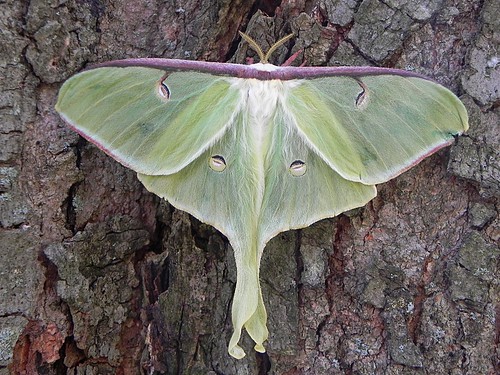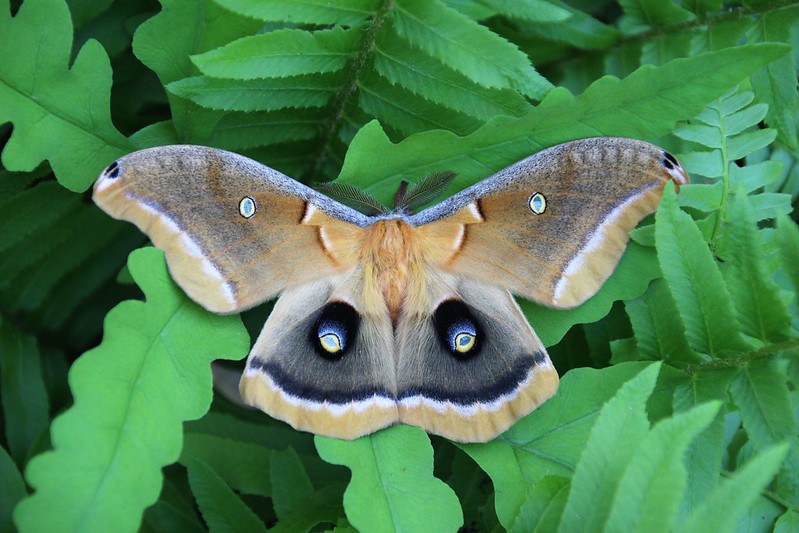Imagine living your life curled up in a blanket surrounded by the dim glow of sun filtering in and the dark black of night for most of your existence. That is how I imagine the life of a giant silk moth to be. There are several kinds of silk moths that live around here, but they all have one thing in common: they all spend most of their lives in a cocoon.
That is not how most people see them, of course. This is the time of year that people call, e-mail, and message the Nature Center with excited descriptions and photos of these huge moths that showed up on their porch with five to six inch wingspans. They describe moths that are lime green or maroon and brown, that are larger than anything they have ever seen in their life.

These are all members of the Giant Silk Moth Family, also known as Saturnids. There are several species of Saturnids in the area. All of them have names that are related to Greek and Roman mythology. There is the lime green Luna Moth, named after the Roman Moon Goddess. The Polyphemous Moth is named after the Greek Cyclops for it’s one eye spot on each wing.
A group of fifth graders on the trail found a Polyphemous moth a couple of years ago and they already knew all about Polyphemous because of the Percy Jackson book series. These young adult books focus on Greek mythology as if it were real. I only learned who Polyphemous was because of the moth, so I was impressed.
The names and related stories of these moths are all interesting, but not as interesting as their wrapped in a blanket life-style. Silk moths emerge in early summer, but live short lives focused on mating. They emerge without mouths or stomachs.
Wait, what? How is that possible? These moths eat everything they need as a caterpillar. These caterpillars get huge, sometimes longer than my hand is wide. Their life as a caterpillar is simple, they eat and eat and hide in the trees. Their huge size makes them a huge meal for the birds that want to eat them or feed them to their young.
The caterpillars wrap themselves in a variety of silk cocoons between mid-summer and fall. Some years have two generations in our area, but most have just one. The caterpillars wrap themselves in silk blankets, hide, and wait. They may spend ten months wrapped up in their cocoon, hidden in leaves or on trees.

This seems like a weird way to spend a life. There is a month or three that is spent as a caterpillar, sitting still during the day and coming out at night to eat. After that, the caterpillars start wandering in search of a place to spend the next ten months in a cocoon. (Audubon phones start ringing in mid- to late-summer with people who have found giant caterpillars.)
It’s blanket time at that point, though the cocoon truly doesn’t keep them warm like a blanket. These cold-blooded creatures don’t need that.
The caterpillar curls up in a cocoon and waits. They miss the colorful changes of fall. They never see the crystal white snow. They even miss the excitement of the first green that covers the forest like mist in the early spring. These are insects of summer and only live active lives in
summer, first as a caterpillar and then less than two weeks as an adult searching for a mate months later.
My brain can’t help but wonder about their cocoon world. Do they notice the change of seasons? Do they sense the cool nights and warm days of fall or the frozen wasteland of winter? Do they freeze solid in winter or stay supercool and not frozen with antifreeze in their bodies? Are they conscious? Do they hear the wind and rain and birds and animals around them?
If you find one of these giant Saturnid moths this summer, don’t worry. They are a valuable part of the local ecosystem. They turn tree leaves into protein, which fuel the flights of birds either as a caterpillar this year or as a moth next year. Enjoy their colors and hugeness, but let them go on their way. Each one has only as short time to find a mate and reproduce before they die.
Audubon Community Nature Center builds and nurtures connections between people and nature. ACNC is located just east of Route 62 between Warren and Jamestown. The trails are open from dawn to dusk as is Liberty, the Bald Eagle. The Nature Center is partially open, including restrooms, the Blue Heron Gift Shop, and some exhibits. More information can be found online at auduboncnc.org or by calling (716) 569-2345.


Recent Comments